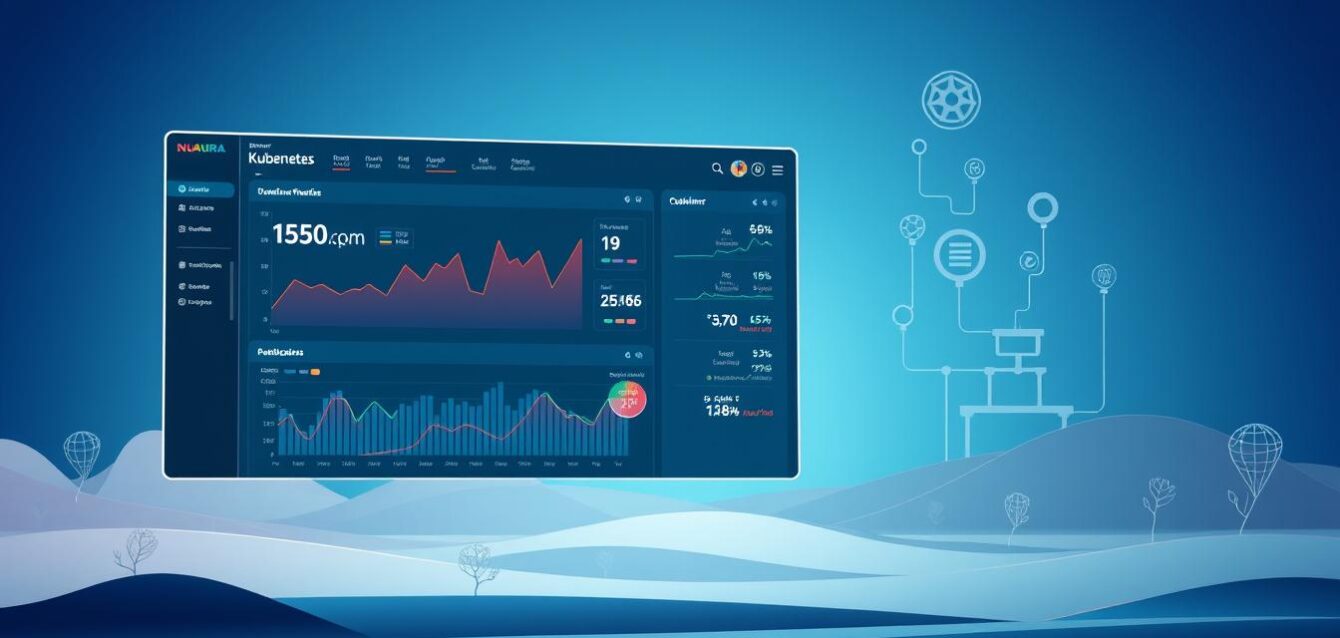Are you finding it hard to improve your container setup with Kubernetes? To manage containers well, you need streamlined monitoring. This ensures your systems run smoothly and avoids problems.
More businesses are using containers, making it harder to manage Kubernetes environments. Kubernetes monitoring is key to spotting problems, using resources wisely, and keeping apps healthy.
With good Kubernetes performance monitoring, companies can fix issues before they cause trouble. This cuts down on downtime and makes deploying apps faster.
Key Takeaways
- Understanding the importance of Kubernetes monitoring for container success
- Identifying the challenges of managing complex Kubernetes environments
- Implementing robust Kubernetes performance monitoring for proactive issue resolution
- Optimizing resource allocation and reducing downtime
- Improving deployment efficiency through streamlined monitoring
The Critical Role of Monitoring in Kubernetes Environments
In the complex world of Kubernetes, monitoring is key to keeping clusters healthy and efficient. It’s not just a tool; it’s a core part of a strong DevOps strategy.
Why Monitoring Matters for Container Orchestration
Monitoring is crucial for container orchestration. It gives real-time insights into your Kubernetes clusters’ performance and health. With good monitoring, you can spot issues early and keep apps running smoothly. Kubernetes monitoring tools track important metrics like CPU, memory, and network traffic.
Common Challenges in Container Visibility and Reliability
Challenges in container visibility and reliability include the dynamic nature of Kubernetes environments. The complexity of microservices and the need for real-time monitoring also pose challenges. To overcome these, a comprehensive monitoring strategy is needed.
- Real-time monitoring of cluster resources
- Alerting and notification systems
- Detailed logging and log analysis
| Challenge | Monitoring Solution |
|---|---|
| Dynamic Environment | Real-time monitoring and auto-discovery |
| Microservices Complexity | Distributed tracing and service mapping |
| Real-time Visibility | High-frequency monitoring and alerting |
By tackling these challenges with effective monitoring, organizations can boost their Kubernetes environments’ reliability and performance.
Understanding Kubernetes Monitoring Fundamentals
Kubernetes monitoring is key for keeping containerized environments running smoothly. It gives insights into cluster performance and health. This helps solve problems early and improve efficiency.
Key Performance Metrics to Track in Kubernetes Clusters
Monitoring Kubernetes means watching several metrics. Node-Level Metrics and Pod and Container Metrics are especially important. They help understand how well the cluster is doing.
Node-Level Metrics
Node-level metrics include CPU usage, memory, and disk performance. These help spot problems with individual nodes.
Pod and Container Metrics
Pod and container metrics look at CPU, memory, and network traffic. They are crucial for seeing how apps perform.
Resource Utilization Monitoring Essentials
Monitoring resource use is vital for Kubernetes cluster optimization. It tracks CPU, memory, and storage to ensure resources are used well.
| Resource | Metrics to Monitor | Importance |
|---|---|---|
| CPU | Usage, Throttling | High CPU usage can lead to performance issues. |
| Memory | Usage, OOM (Out-of-Memory) events | Memory leaks can cause application crashes. |
| Storage | Usage, IOPS (Input/Output Operations Per Second) | Storage issues can impact data persistence and performance. |
Application Performance Monitoring in Kubernetes
APM in Kubernetes tracks app-specific metrics. APM tools find performance bottlenecks and help improve app code.
By grasping these monitoring basics, organizations can make sure their container apps run well.
Implementing Effective Kubernetes Monitoring Systems
Kubernetes monitoring is more than just tracking resources. It’s a detailed process. To keep containerized apps healthy and running well, you need a good monitoring system.
Step1: Defining Your Monitoring Requirements and Objectives
First, you must clearly define what you need to monitor. This means figuring out the key metrics, what different people need to see, and how wide your monitoring should be.
Step2: Setting Up Core Monitoring Infrastructure
Building the core of your monitoring system is key. This means:
- Installing monitoring agents to gather data from various places.
- Setting up how to collect data so you get the right metrics.
Installing Monitoring Agents
Agents like Prometheus are crucial for getting metrics from Kubernetes clusters. Make sure they’re installed and set up right.
Configuring Data Collection
Configuring data collection is about deciding what metrics to get, how often, and where to store them. Doing this well means your monitoring system gives you useful insights.
Step3: Establishing Alert Thresholds and Notification Channels
Setting up alerts and notifications is key for catching problems early. This means setting alerts based on certain levels and making sure teams get notified.
| Step | Description | Tools Involved |
|---|---|---|
| 1 | Defining Monitoring Requirements | Kubernetes APIs, Monitoring Tools |
| 2 | Setting Up Monitoring Infrastructure | Prometheus, Grafana |
| 3 | Establishing Alert Thresholds | Alertmanager, Notification Services |
Kubernetes Monitoring Best Practices for Production Environments
To keep your Kubernetes environment running smoothly, it’s key to follow the best monitoring practices. Good monitoring helps teams spot and fix problems before they affect users.
Implementing Proactive Monitoring Strategies
Proactive monitoring means setting up alerts for potential issues before they get serious. It’s about watching important metrics like CPU, memory, and network traffic.
Key strategies include:
- Configuring alerts based on threshold breaches
- Implementing anomaly detection to identify unusual patterns
- Regularly reviewing logs to detect early signs of problems
Optimizing Monitoring Resource Consumption
Monitoring uses resources, so it’s important to use them wisely. This avoids slowing down your Kubernetes cluster. Here are some ways to optimize:
- Right-sizing monitoring components
- Implementing efficient data storage solutions for logs and metrics
- Using sampling and aggregation techniques to reduce data volume
Integrating Monitoring with CI/CD Pipelines and DevOps Workflows
Linking monitoring with CI/CD pipelines makes the feedback loop stronger. It lets developers fix issues early. This integration offers:
- Automated testing of monitoring configurations
- Feedback on application performance and reliability
- Continuous improvement of monitoring strategies based on production data
By following these best practices, you can greatly improve your Kubernetes monitoring. This leads to more reliable and efficient containerized apps.
Essential Kubernetes Monitoring Tools and Solutions
In Kubernetes, monitoring is more than just seeing what’s happening. It’s about using the best tools to manage things before problems start. This way, teams can fix issues before they affect users, keeping everything running smoothly.
Open-Source Monitoring Solutions
Prometheus and Grafana are top picks in the Kubernetes world. Prometheus is great at gathering metrics. Grafana makes it easy to see those metrics in a clear way. Together, they create a flexible monitoring system.
Commercial Kubernetes Monitoring Platforms
Commercial platforms offer more features like automated monitoring and AI insights. They also have better alerting systems. These tools make monitoring Kubernetes easier, giving you a single view of all your clusters.
Selecting the Right Monitoring Stack
Choosing the right monitoring tools depends on several things. These include how big your Kubernetes setup is, what you need to monitor, and what you already have. A mix of open-source and commercial tools can offer the best of both worlds.
| Monitoring Aspect | Open-Source Solutions | Commercial Platforms |
|---|---|---|
| Customizability | High | Variable |
| Scalability | High | High |
| Cost | Low | Variable |
Dan Barker, a Kubernetes expert, says, “The secret to good Kubernetes monitoring is not just the tools. It’s how you use them in your workflow.” Making sure your tools fit well with your workflow is key to getting the most out of them.
Conclusion: Mastering Kubernetes Monitoring for Container Success
Effective Kubernetes monitoring is key to container success. Understanding the basics and having a solid monitoring plan helps. This way, organizations can make their container orchestration better and run smoothly.
Kubernetes monitoring helps teams spot problems early. This cuts down on downtime and makes systems more reliable. With tools like Prometheus and Grafana, teams get instant insights into their clusters. They can make better decisions based on data.
To truly master Kubernetes monitoring, it’s important to link it with CI/CD pipelines and DevOps. This lets teams find and fix issues quickly. By following the advice in this article, organizations can make the most of their Kubernetes setup. This leads to business success.
FAQ
What are the key benefits of implementing Kubernetes monitoring?
Kubernetes monitoring gives you insights into how your cluster is doing. It shows how resources are used and if apps are healthy. This helps you find problems early, use resources better, and make apps run smoother.
How does Kubernetes monitoring differ from traditional monitoring approaches?
Kubernetes monitoring is made for the fast-changing world of containers. It looks at pod and container health, node status, and resource use. Traditional monitoring focuses more on single hosts or apps.
What are some essential Kubernetes monitoring tools?
Key tools for Kubernetes monitoring include Prometheus and Grafana, which are free. There are also paid options that offer more features and support. These tools help you understand your Kubernetes cluster well.
How can I optimize Kubernetes resource utilization through monitoring?
By watching how resources like CPU and memory are used, you can spot where they’re not being used right. This lets you adjust your containers to use resources better. It makes your cluster more efficient and can save money.
What are some best practices for Kubernetes application performance monitoring?
Good practices include using distributed tracing and watching app-specific metrics. Also, use Kubernetes tools to understand how apps perform. This helps find ways to make them better.
How can I integrate Kubernetes monitoring with my CI/CD pipelines?
By linking Kubernetes monitoring with CI/CD pipelines, you can keep an eye on things all the time. This lets you catch problems early and make apps run better. Use tools that work with CI/CD and DevOps.
What are some common challenges in Kubernetes cluster monitoring?
Challenges include dealing with complex systems, lots of data, and seeing what’s happening in a big, spread-out setup. But, you can overcome these with good strategies and the right tools.
How can I ensure effective Kubernetes performance monitoring?
To monitor Kubernetes well, track important metrics like node, pod, and container performance. Use tools that give you live updates and alerts. This helps catch problems before they affect apps.




